1. Overview of the Da Nang Museum of Cham Sculpture
1.1. History of the Museum of Cham Sculpture
The Da Nang Museum of Cham Sculpture is also known as the Ancient Museum of Cham and has the same full name as the Museum of Cham Sculpture Art. With a total actual area of the museum of up to 6673 m2, of which 2,000 m2 is an area for displaying ancient relics.
Visitors have the opportunity to explore the ancient, flourishing kingdom of Champa with its historical cultural values and the unique quintessence of Cham sculpture.

The Museum of Cham Sculpture was built between 1915 and 1919 by the French. At the end of the 19th century, there appeared a number of large-scale archaeological investigations of the Champa culture that were conducted by the French.
And since then, the museum of Cham sculpture was first expanded in the mid-1930s to accommodate more artifacts excavated in the 1920s and 1930s. Gradually, this Cham museum has undergone three times of restoration, expansion, and construction: in 2002, 2005, and 2016.
1.2. Where are the Danang Museum of Cham Sculptures opening hours and ticket prices?
- Address: 02 September 2nd Street, Binh Hien Ward, Hai Chau District, Da Nang City.
- Tel: (+84) 236 3572 935
- Open: Từ 7:00 a.m – 17:00 p.m
- Ticket price: 2.6 USD/person/way; In particular, the museum also has a policy of exemption and reduction of fees for some special cases.
- Email: gdtt-baotangcham@danang.gov.vn
- Web: https://chammuseum.vn/default.aspx
1.3. Instructions on How to Go to the Danang Museum of Cham Sculpture
1.3.1. Road to the Museum
- From the airport to the Museum is about 3 km.
- From the train station to the Museum is about 4 km.
- From the bus station to the Museum is about 10 km.
- From the harbor to the Museum about 12 km
- Instructions on How to Go to the Danang Museum of Cham Sculpture
The Da Nang Museum of Cham Sculpture is located only about 3 km from the center of Da Nang city to the east and about 29 km to the west. Therefore, you can still take a car, a motorcycle, or a bus to come here.
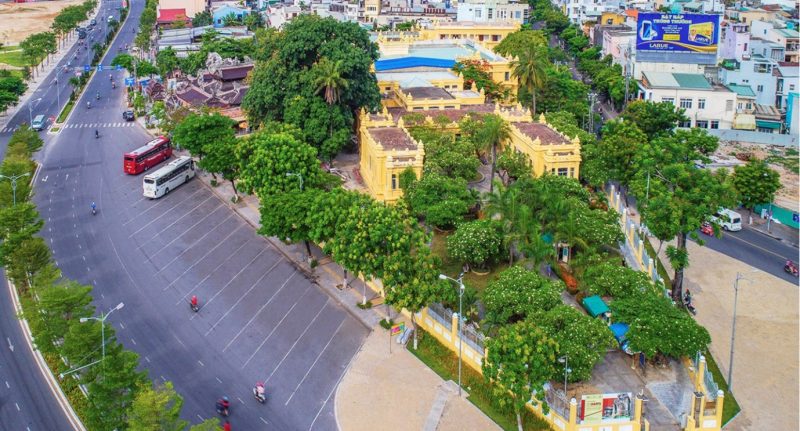
Going to the Danang Museum of Cham Sculpture by Car or Motorcycle
You can move to the Cham Museum by taxi or rent a private car in Da Nang comfortably to visit without fear of rain or sun. Or you can experience a cool and comfortable feeling when you drive a motorbike by yourself along the sea road to the Museum of Cham Sculpture.
Going to the Danang Museum of Cham Sculpture by Bus
Depart from the Da Nang city center bus station (Quang An Industrial Joint Stock Company 1) to catch the bus routes going through the inner city to the Cham Museum. The average time of the bus routes here is 20 minutes to 30 minutes.
- Ticket price: from 0.2 USD – 0.4 USD/way.
Interesting experience when visiting the Museum of Cham Sculpture in Da Nang
The Cham Sculpture Museum is one of the tourist attractions in Da Nang with bold cultural and historical values. The unique architecture and sculpture of the ChamPa people not only attract Vietnamese people but also many foreign tourists who also express their curiosity about an ancient civilization.
1.3.2. Admire the impressive architecture of the Champa Sculpture Museum
The museum was designed by two French architects, Delaval and Auclair, using the contours of the Cham Pa temples combined with European Gothic architecture.
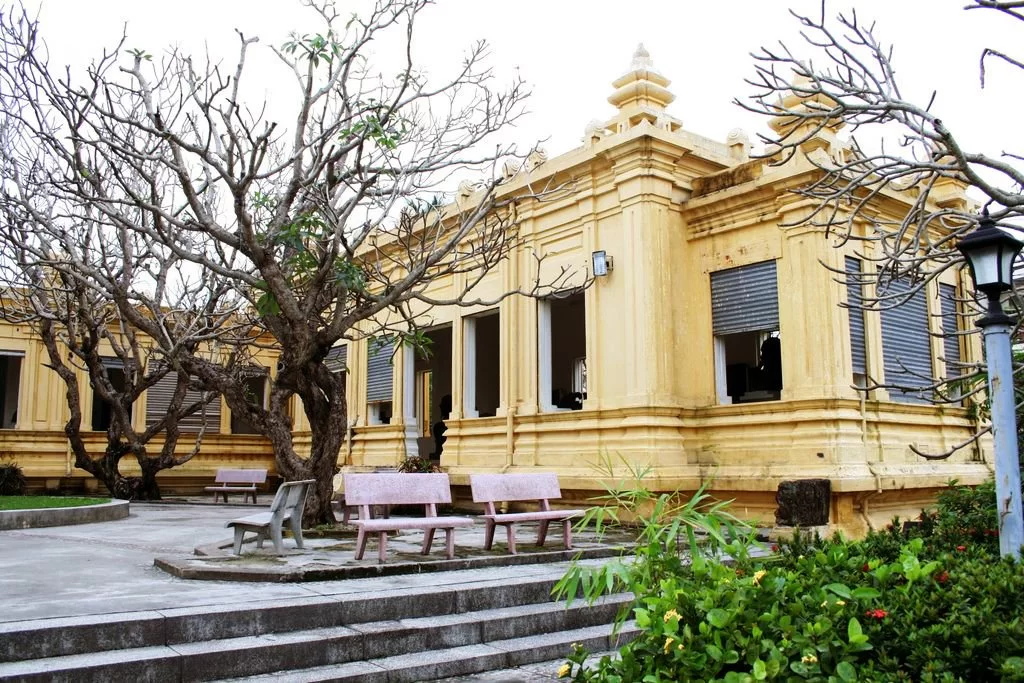
The main building features an arc-shaped dome with a pointed tip, helping the museum stand out in the heart of the city. Stepping into the museum grounds, visitors will notice an ancient atmosphere with classical architectural blocks, mossy yellow walls, and pure white porcelain flowers.
Also thanks to the museum’s architecture with many windows, most of the museum’s exhibition areas are naturally lit. In addition to possessing the above-mentioned beautiful and unique architectural space, the museum also has a diverse collection of antiques with many valuable values.
1.4. Go to the ChamPa Sculpture Museum and visit the unique gallery
When visiting the Da Nang Museum of Cham Sculpture, visitors will be able to visit the galleries with a number of archives totaling more than 2,000 large and small antiques, of which about 500 are displayed and the rest are stored. carefully stored in the warehouse. These sculptures are mostly original, dating from the 7th to the 15th centuries.
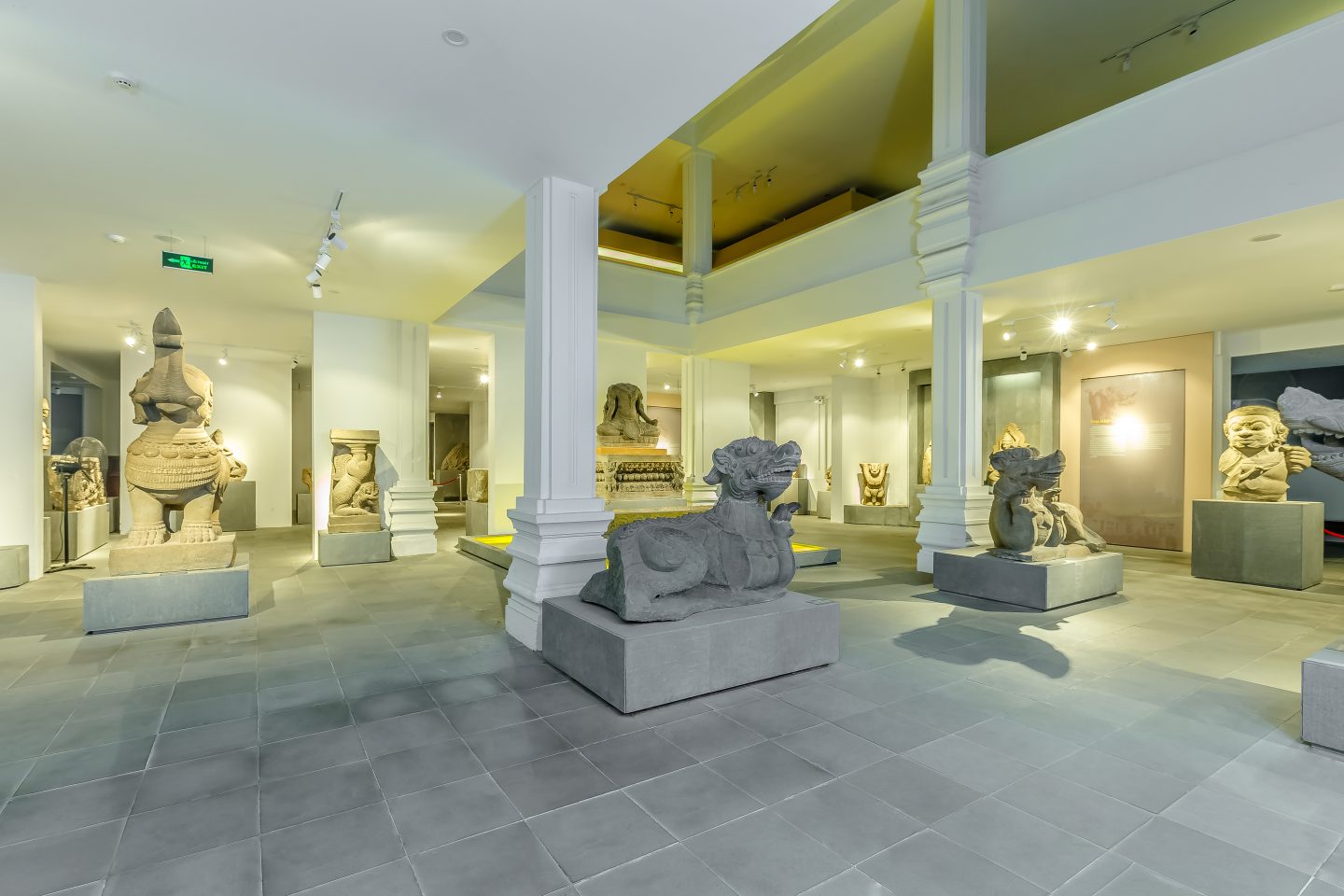
These artifacts are classified into galleries according to the geographical area in which they were excavated, such as: Dong Duong, Tra Kieu, Thap Mam, My Son, Quang Nam, Quang Ngai, Quang Binh, Quang Tri, Thua Thien-Hue,Da Nang, Binh Dinh, Kon Tum, Van Khac, etc. This division not only makes it convenient for visitors to visit but also easily recognizes the unique imprint of Cham architecture in each locality.
1.5. The Da Nang Museum of Cham Sculpture keeps a large number of antiquities
This place keeps more than 2000 antiques of different sizes. All have been collected by many people who are passionate about antiques across the country. Among those antiques of historical value, about 1200 are kept carefully inside the warehouse and have not been put on display. More than 185 artifacts are displayed on the outside, or campus, of the museum.
At the Museum of Cham Sculpture in Da Nang, there are currently three antiquities classified as national treasures:
The statue of Bodhisattva Tara is the only bronze work in the Museum of Cham Sculpture. With a height of 1,148m, this is also the largest bronze statue of Cham sculpture up to the present time.
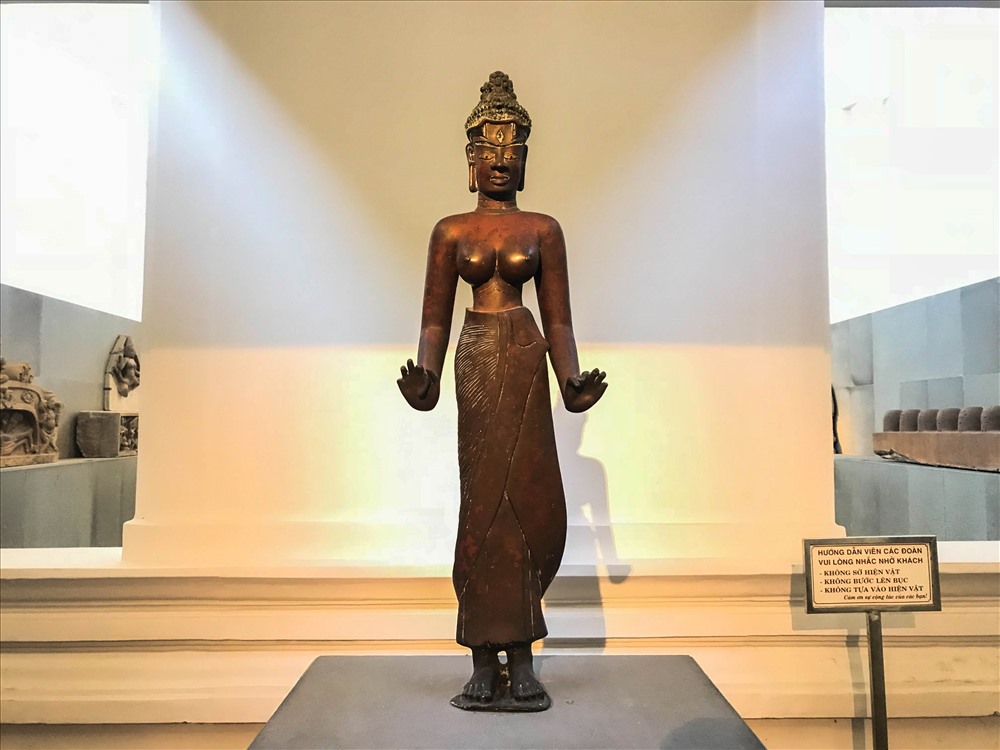
Tra Kieu worshiping tower, the place connecting gods and temples, connecting heaven and earth, is the only Champa worship station that is still relatively intact, with a square pedestal below and a round Yoni pedestal above.
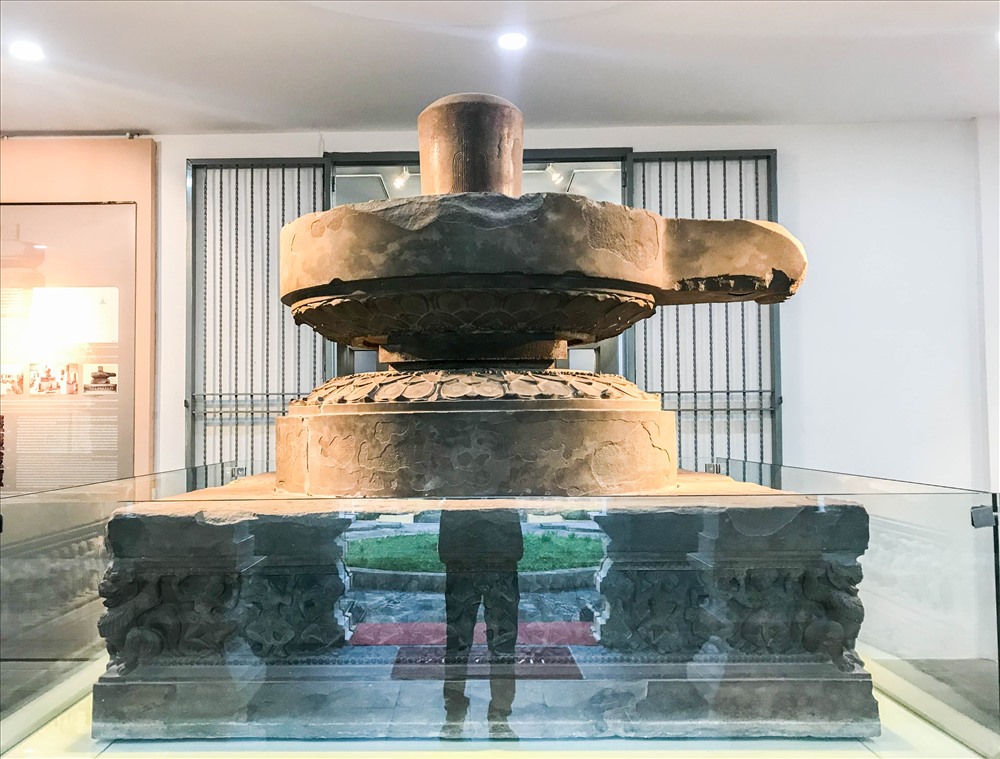
My Son E1 altar is an antiquity of particularly important value to the Champa kingdom and an important piece of evidence to help decipher the ancient Cham culture.
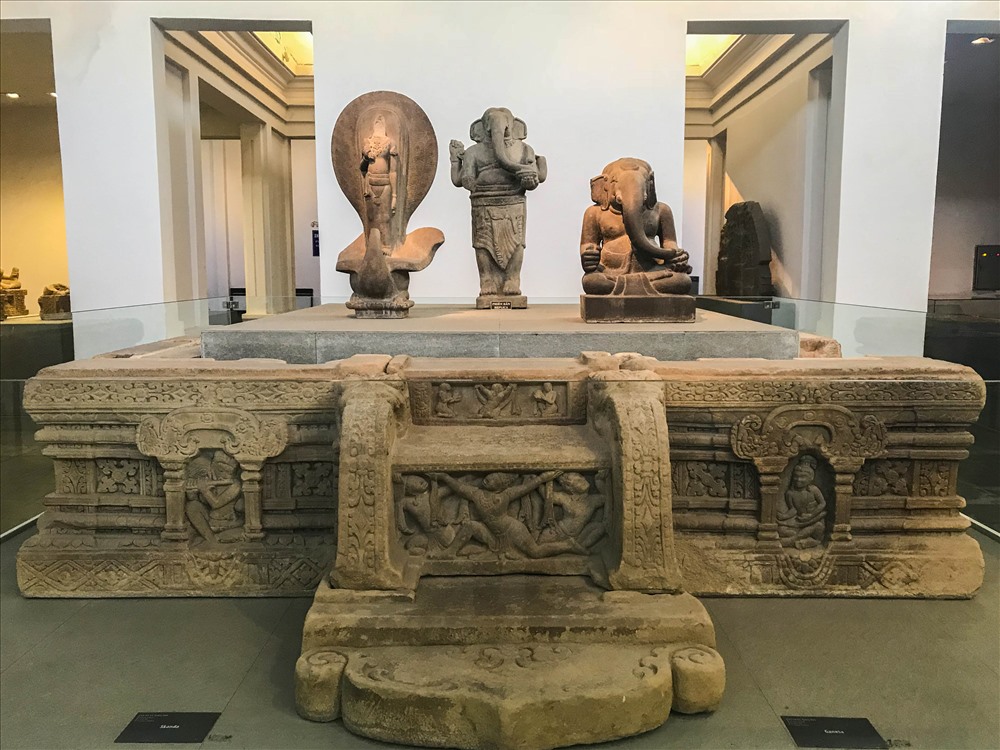
1.6. Listen to the explanation about the Museum of Cham Sculpture in Da Nang
Thanks to these ancient artifacts, you can learn more about Champa culture and discover its interesting meanings. Moreover, there is more knowledge of the history of a once very prosperous country called Cambodia.
In order for visitors to learn more about the ChamPa culture, the museum also provides two additional services: automatic narration (an audio guide) and a tour guide for the group.
1.6.1. Electronic Narration Service using Headphones (Audio Guide)
Step 1: Access the wifi system at the museum.
Step 2: Open a web browser and access the address: https://chamaudio.com.
Step 3: Select the language (Vietnamese, English, or French) and the object you want to hear information about. Visitors can scan the codes attached to the objects or follow the tour sequence introduced in the app.
1.6.2. Interpretation service for groups
Catering in the following languages for groups of 5 or more: Vietnamese, English, and French.
Service time: 7:30 a.m. – 11:00 p.m; 14:00 p.m – 17:00 p.m
Note: The department will stop accepting registrations at the counter before 10 a.m. in the morning and before 4 p.m. in the afternoon to ensure the minimum time for the explanation according to the itinerary.
Groups accompanied by a guide or requiring instruction in English and French should contact us at least three days in advance.

2. Notes when visiting the Museum of Cham Sculpture
- Visitors must present a ticket to visit the museum. Dress neatly and politely.
- Do not bring weapons, explosives, flammable substances, toxic substances such as acids and corrosive substances, oversized furniture, and other dangerous items into the museum.
- Do not bring large luggage into the museum. Hand luggage over 3 kg must be deposited at the luggage counter (money and high-value items need to be brought with you).
- Do not smoke, wear raincoats, or eat in the galleries. Maintain general hygiene and dispose of garbage in designated places. No street vendors are allowed on the museum premises.
- Do not bring banners, banners, or pets into the museum. Do not make noise when visiting the museum.
- Do not touch artifacts, do not climb, and do not sit on the podium displaying artifacts in the museum.
- Do not use a tripod or flash to take pictures. Special filming and photography programs must be approved by the museum’s leader.
- Do not arbitrarily organize entertainment, cultural, and artistic activities on the museum’s premises without the permission of the leader of the museum.
- Do not climb trees, break branches, pluck flowers, pick fruits, etc., on the museum’s premises.
- Visitors are responsible for causing damage to the museum.
The Da Nang Museum of Cham Sculpture is a place to preserve, preserve, and promote the material cultural values of the ancient Champa period. This is a heritage destination with very high cultural and artistic value. Hopefully the information Metta Voyage has just provided will suggest a valuable destination.
Contact us
Trang web: www.mettavoyage.com
Email: info@mettavoyage.com
Hotline 24/7: + 84 989 383 572


0 Comment